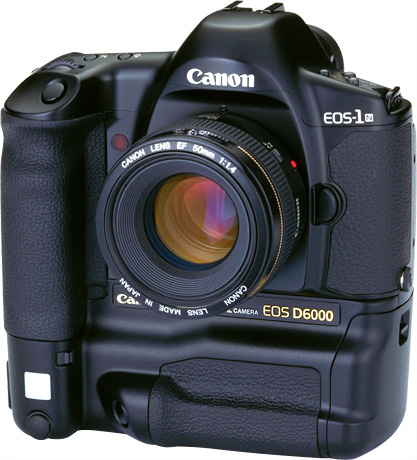 Japan
Japan Americas
Americas Europe, Asia, Oceania
Europe, Asia, Oceania
- Outline
- Specifications
| Marketed | December 1998 |
| Original Price | 3,600,000 yen |
The EOS D6000 is the successor to the EOS DCS1, which was marketed in Japan in 1995. Placing the greatest emphasis on image quality, the D6000 is aimed at the top of the professional digital market for advertising and artistic photography.
The camera and digital sections have been integrated, resulting in a much more compact and better handling unit. The new 6 megapixel CCD gives much better color reproduction. It is the world’s highest-resolution digital field camera using a single CCD at the time. Mode setting and dial operations are the same as the EOS-1N, and uses the entire, very extensive lineup of interchangeable EF lenses, making switching from film to digital a snap for EOS users. Immediately after exposure the image can be checked on the 1.8″ color LCD monitor, located on the back of the camera. Continuous shooting at one fps for up to three frames, and quick, accurate, natural-looking E-TTL automatic flash exposures with EX Speedlites are possible.
Two PCMCIA card slots accept two Type I or Type II cards, or one Type III card. The next generation IEEE1394 interface is used for high-speed data transfer.
| Type | AF single-reflex lens digital camera. Single-shot camera with 36 bit full-color (RGB each 12 bits). Object frame size: 18.4 x 27.6mm. 6 megapixel CCD (3040 horizontal x 2008 vertical pixels. Aspect ratio = 2:3. Maximum burst: 3 frames. Maximum frame rate: One fps at 1/250 second shutter speed or higher. |
| Compatible Lenses | Canon EF lenses (focal length increases by approximately 1.3 x) |
| Mount | EF mount |
| AF system | TTL cross type secondary image phase differential detection. Cross-type BASIS for AF sensor. AF modes: One-Shot AF and predictive AI Servo AF, Manual. AF metering range: EV 0-18. |
| Shutter speed | 1/8000 to 30 sec. B, X= 1/250 sec. (maximum sync speed) |
| Viewfinder | Full-frame single lens reflex type. Coverage: 97% vertically and horizontally. 0.83x magnification. 20mm eye relief. New Laser Matte screen is standard. Eight interchangeable focusing screens. Built-in dioptric adjustment. |
| Metering and Exposure Control |
Metering and Exposure Control: Evaluative metering with 12-zone SPC and TTL full-aperture metering using BASIS (also Center-weighted averaging metering using a Custom Function (CF). Partial metering, Spot metering, Fine spot metering (also AF point-linked spot metering using a Custom Function). Metering range (at ISO 100): EV 0-20 with evaluative and partial metering. EV 3-20 with fine spot metering. Exposure compensation: ±3EV. ISO range: 80-200. E-TTL automatic flash exposure with a Canon EX Speedlite. |
| White balance | 5 presets (Auto, Daylight, Tungsten, Fluorescent, Flash) and custom. |
| Recording media | PCMCIA-ATA Type I, II and III PC card |
| Data file format | TIFF (Lossless Compression Raw Data) |
| Data file size | Recording: approximately 6MB. Capturing: approximately 18MB (8 bit acquiring) approximately 36MB (12 bit acquiring). Recording capacity: approximately 50 frames (when using 340MB PC card). Audio recording: possible on each shot via built-in microphone. |
| Interface | IEEE1394 PCMCIA Type II x 2. Driver software: Plug-in for Macintosh Adobe Photoshop and TWAIN driver for PC. |
| Built-in color monitor | 1.8″ color LCD (Image confirmation, Histogram, Overexposure warning, and other warnings/indicators). |
| Infrared-cut Low-Pass Filter | Built-in, removable by the user. |
| Power source | Replaceable rechargeable Ni-Cd battery (up to 100 frames capacity when fully charged). AC power input possible through AC adapter (Ni-Cd charger can be powered by AC adaptor or Car battery adaptor). AC Power Input: 95-250V / 47-63Hz. |
| Dimensions & Weight | 161 x 174 x 92mm, 1650g (without battery) |
| Outline | Specifications Catalog Sample Images |


